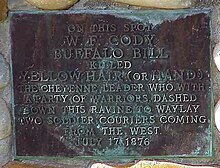This article needs additional citations for
verification. (June 2012) |
| Battle of Warbonnet Creek | |||||||
|---|---|---|---|---|---|---|---|
| Part of the Great Sioux War of 1876 | |||||||
| |||||||
| Belligerents | |||||||
| Cheyenne |
| ||||||
| Commanders and leaders | |||||||
| Little Wolf |
| ||||||
| Strength | |||||||
| ~200-300 | ~350 | ||||||
| Casualties and losses | |||||||
|
1 killed unknown wounded | None | ||||||
The Battle of Warbonnet Creek was a skirmish characterized by a duel between "Buffalo Bill" Cody and a young Cheyenne warrior named Heova'ehe or Yellow Hair (often incorrectly translated as "Yellow Hand"). [1] The engagement is often referred to as the First Scalp for Custer. It occurred July 17, 1876, in Sioux County in northwestern Nebraska.
Background
After the defeat of Gen. George A. Custer at the Battle of the Little Big Horn, many Native Americans joined with Sitting Bull and Crazy Horse, encouraged by the Indians' success. About 200-300 Cheyenne warriors led by Morning Star (also known as Dull Knife) set out with their families from the Spotted Tail and Red Cloud agencies in Nebraska.
The United States Army had sent the 5th Cavalry Regiment, commanded by Lt. Col. Eugene Asa Carr, from Oklahoma to a position on the Cheyenne River in South Dakota to guard against such an occurrence. Carr was replaced in command on July 1 by Col. Wesley Merritt, and when news of the Battle of the Little Big Horn reached Gen. George Crook on July 5, the 5th Cavalry was ordered to reinforce Crook on Goose Creek in Wyoming.
Engagement
Word of the breakout of the Cheyenne also reached Merritt and, guided by "Buffalo Bill" Cody, he was able to intercept the Cheyenne warriors.

Merritt planned an ambush. He hid most of his 350 troopers inside covered wagons and posted sharpshooters nearby out of sight. Spotting Merritt's seemingly unescorted wagon train along Warbonnet Creek, a small war party of six Cheyenne warriors charged directly into the trap to divert attention from the main body of Cheyenne.
A few warriors were wounded by the troopers, but the only real action of the engagement was a "duel" between Buffalo Bill and a Cheyenne chief, Yellow Hair. Cody shot and killed the Indian with his Winchester carbine, then pulled out a Bowie knife and scalped him.
The main body of warriors attempted to rescue the small war party, but fled so quickly after seeing the true strength of the U.S. forces that not a single trooper was killed or injured.
Aftermath
Merritt joined Crook, whose expedition later linked up with that of Gen. Alfred H. Terry, bringing the combined strength of the U.S. force to about 4,000.
Ever the showman, Buffalo Bill returned to the stage in October, his show highlighted by a melodramatic reenactment of his duel with Yellow Hair. He displayed the fallen warrior's scalp, feather war bonnet, knife, saddle and other personal effects. [2] He later often celebrated the killing during his Wild West shows in a reenactment he entitled "The Red Right Hand, or, Buffalo Bill's First Scalp for Custer". [3]
See also
Notes
-
^ Apparently[
weasel words] not the same Yellow Hair as the brother of
Wooden Leg, who was killed while on a hunting trip the following year. - Marquis, Thomas B. (translator); Wooden Leg (2003).
Wooden Leg: A Warrior Who Fought Custer.
University of Nebraska Press. pp. chap. 13.
ISBN
978-0-8032-8288-9.
{{ cite book}}:|first1=has generic name ( help) - ^ Cold Spots - Hat Creek Battlefield[ unreliable source?]
-
^
Louis Berger Group (August 2005).
Nebraska Historic Buildings Survey Sioux County (PDF).
Nebraska State Historical Society. Archived from the original on November 16, 2006. Retrieved 26 June 2017.
{{ cite book}}: CS1 maint: unfit URL ( link)
Further reading
- Dillon, Richard H. (1997). North American Indian Wars. Greenwich: Bramley Books. ISBN 978-1858337678.
- Greene, Jerome A. (1994). Lakota and Cheyenne : Indian views of the Great Sioux War, 1876-1877. Norman: University of Oklahoma Press. ISBN 978-0-8061-2681-4.
- Finerty, John F. (1890). War-path and bivouac, or, The conquest of the Sioux (Reprint. ed.). Chicago: Donohue & Henneberry. ISBN 978-1582181943.
- Hedren, Paul L. (2005). "The Contradictory Legacies of Buffalo Bill Cody's First Scalp for Custer". Montana: The Magazine of Western History. 55 (1): 16–35. JSTOR 4520671.
- Hedren, Paul L. (1980). First scalp for Custer : the skirmish at Warbonnet Creek, Nebraska, July 17, 1876 : with a short history of the Warbonnet Battlefield. Glendale, Calif.: A.H. Clark Co. ISBN 978-0870621376.
- King, James T. (1 July 1982). "Review: First Scalp for Custer: The Skirmish at Warbonnet Creek, Nebraska, July 17, 1876, with a Short History of the Warbonnet Battlefield". The Western Historical Quarterly. 13 (3): 329–330. doi: 10.2307/969431. ISSN 0043-3810. JSTOR 969431. Retrieved 26 June 2017.
- Russell, Don (1937). "The Duel on the War Bonnet". The Journal of the American Military Foundation. 1 (2): 55–69. doi: 10.2307/3038720. JSTOR 3038720.
- Vestal, Stanley (1940). "The Duel With Yellow Hand". Southwest Review. 26 (1): 65–77. JSTOR 43466577.
External links
- "Warbonnet Battlefield Monument". U.S. Forest Service. Retrieved 2012-10-21.